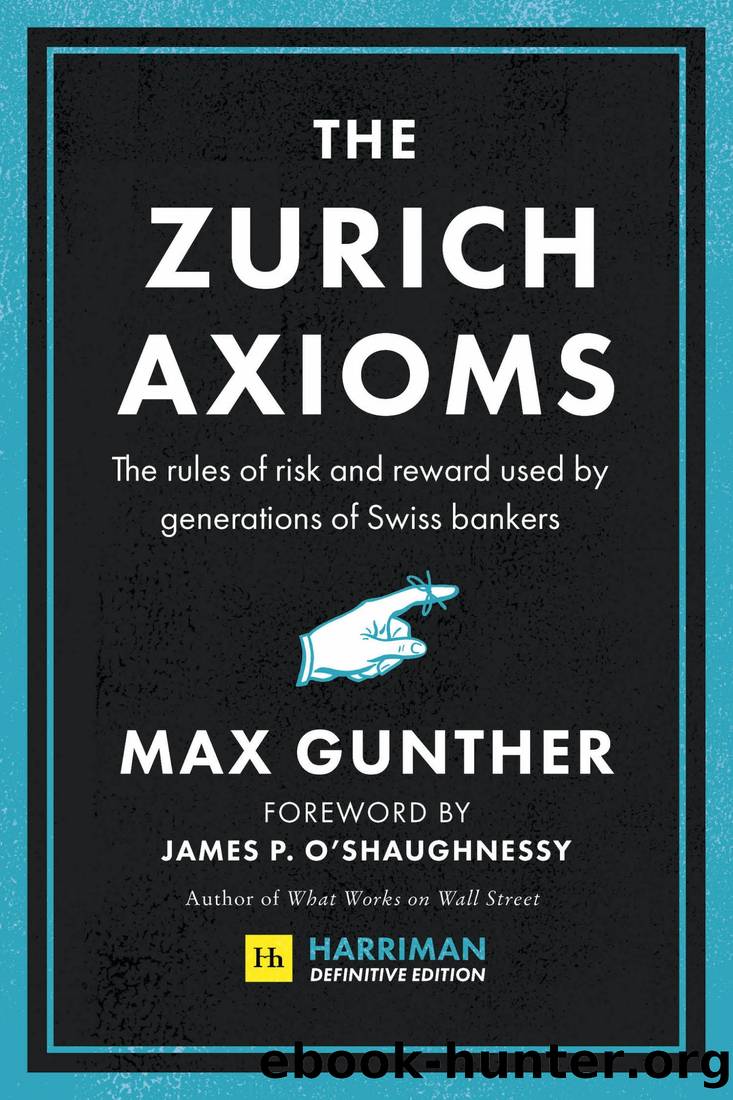The Zurich Axioms (Harriman Definitive Edition): The Rules of Risk and Reward Used by Generations of Swiss Bankers by Max Gunther

Author:Max Gunther [Gunther, Max]
Language: eng
Format: epub
Tags: Business & Economics, Investments & Securities, General
ISBN: 9780857199065
Google: tgYBEAAAQBAJ
Publisher: Harriman House Limited
Published: 2020-10-06T00:08:46.846523+00:00
Minor Axiom VII: Beware the Correlation and Causality Delusions.
There is an old story about a fellow who stands on a street corner every day waving his arms and uttering strange cries. A cop goes up to him one day and asks what itâs all about. âIâm keeping giraffes awayâ, the fellow explains. âBut weâve never had any giraffes around hereâ, says the cop. âDoing a good job ainât I?â says the fellow.
It is characteristic of even the most rational minds to perceive links of cause and effect where none exist. When we have to, we invent them.
The human mind is an order-seeking organ. It is uncomfortable with chaos and will retreat from reality into fantasy if that is the only way it can sort things out to its satisfaction. Thus, when two or more events occur in close proximity, we insist on constructing elaborate causal links between them because that makes us comfortable.
It can also make us vulnerable, but we donât usually think of that until it is too late.
Iâll give you a personal example. Many years ago, before Frank Henry and I had talked much about the Zurich Axioms. I made a little money jumping back and forth between IBM and Honeywell stock. Honeywell in those days was heavily committed to building big, general-purpose computers and was a direct competitor of IBM to a much greater extent than is true today. Over a period of eighteen months or so, I noticed that the two stocksâ prices often moved in opposite directions. When Honeywell climbed for a few weeks, IBM would be drooping, and vice versa. I put a little money into what I thought was a very smart parlay: ride Honeywell up a way, jump off, buy IBM at a low point, ride that up⦠and so on.
It worked tolerably well a couple of times. I should have realized it was working only because I was lucky, but I wasnât that smart in those days. I thought it was working because⦠because⦠well, I constructed a causal relationship to fit the phenomenon I had been witnessing.
I theorized that there were a lot of big investors â mutual funds, insurance companies, and wealthy private plungers â who periodically shifted enormous mountains of cash from IBM to Honeywell and back. When Honeywell announced an attractive new product or made some other good move, all those hypothetical fat cats would sell off IBM stock in order to load themselves up with Honeywell â and vice versa. This rigged-up hypothesis, if true, would explain the opposite motions of the two stocksâ prices.
Was it true? Almost certainly not. The truth undoubtedly was that the seemingly orderly price movements had been caused by events that coincided by pure chance. These events were random and unpredictable. The fact that those opposite price moves had occurred a few times in the past was no indication, and should never have been taken as an indication, that they would recur in the future. But my rigged-up causal relationship made the whole minuet seem more orderly than it was, and I confidently bet too much money on it.
Download
This site does not store any files on its server. We only index and link to content provided by other sites. Please contact the content providers to delete copyright contents if any and email us, we'll remove relevant links or contents immediately.
Zero to IPO: Over $1 Trillion of Actionable Advice from the World's Most Successful Entrepreneurs by Frederic Kerrest(4289)
Machine Learning at Scale with H2O by Gregory Keys | David Whiting(4178)
Never by Ken Follett(3789)
Harry Potter and the Goblet Of Fire by J.K. Rowling(3773)
Ogilvy on Advertising by David Ogilvy(3509)
Shadow of Night by Deborah Harkness(3302)
The Man Who Died Twice by Richard Osman(2997)
Book of Life by Deborah Harkness(2867)
The Tipping Point by Malcolm Gladwell(2827)
Will by Will Smith(2791)
0041152001443424520 .pdf by Unknown(2784)
My Brilliant Friend by Elena Ferrante(2773)
How Proust Can Change Your Life by Alain De Botton(2742)
Purple Hibiscus by Chimamanda Ngozi Adichie(2651)
How to Pay Zero Taxes, 2018 by Jeff A. Schnepper(2602)
Hooked: A Dark, Contemporary Romance (Never After Series) by Emily McIntire(2497)
Rationality by Steven Pinker(2291)
Borders by unknow(2227)
Can't Hurt Me: Master Your Mind and Defy the Odds - Clean Edition by David Goggins(2225)
